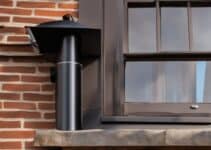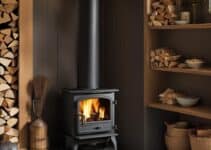Amidst the evolving landscape of home heating solutions, many of us in England find ourselves seeking alternatives to traditional log burners. The imperative for change is driven by an increased awareness of pollution concerns and the potential fines associated with emissions. As I delve into log burner alternatives, one can’t help but consider the balance between efficiency and environmental stewardship. The query “What is the best alternative to a log burner?” leads to a discourse on efficient home heating options that cater to both our need for sustainable heating options and our desire for that familiar warmth of a hearth.
Alternative heating methods such as electric fires, gas fires, and bioethanol burners are on the ascendant, offering an array of benefits that align with current trends towards renewable energy and the advantages of minimal installation requisite. An electric fireplace, with its remote control functionality and chimney-less installation, emerges as a particularly forward-thinking choice. As we navigate the myriad of options available, it is imperative we weigh up aspects such as aesthetic appeal, reduced emissions, and the adaptability to homes lacking traditional chimney structures.
Understanding the Environmental Impact of Log Burners
In my quest to elucidate the subject of wood stove alternatives, it becomes evident that the environmental repercussions of traditional log burners cannot be ignored. As a matter of urgency, the 2019 Clean Air Strategy was introduced in the UK to mitigate the deleterious effects on both the environment and public health posed by these stoves. This progressive legislation advocates for the adoption of eco-friendly heating options and establishes stringent criteria for wood fuel moisture levels, signaling the imperative shift toward cleaner, renewable heating alternatives.
The ramifications of wood-burning stoves stretch beyond the confines of a cosy home and permeate the ecosystem, leaving a trail of particulate matter and other pollutants. To illuminate the gravity of these concerns, it is important to scrutinise the emissions statistics stemming from traditional log burning. As such, I’ve compiled a table that juxtaposes wood burners with their eco-friendly counterparts to foster an informed analysis:
| Emission Type | Traditional Wood Stove | Eco-Friendly Alternative |
|---|---|---|
| Particulate Matter (PM) | High | Low to None |
| Carbon Monoxide (CO) | Variable | Minimal or None |
| Nitrogen Oxides (NOx) | Present | Significantly Reduced or Absent |
| Volatile Organic Compounds (VOCs) | Present | Reduced or Absent |
| Carbon Dioxide (CO2) | Significant | Lower |
With these factors in mind, it’s clear that the impetus behind the transition to more sustainable heating methods is well-founded. It’s incumbent upon us to eschew the traditional in favour of innovation that safeguards our well-being and conserves the sanctity of our environment. My exploration thus pivots towards such novel solutions, promising a harmonious coalescence of efficiency and stewardship.
Electric Fireplace Alternatives: Cosy and Convenient Heating
As someone passionate about sustainable heating options, I’m always exploring efficient home heating systems. Electric fireplace alternatives stand out as not only kind to the environment but a stylish addition to modern homes.
Electric ‘Fire’: The Benefits of Installation and Aesthetics
The allure of electric fireplaces hinges on their ease of installation – a game-changing feature. Absent the need for a chimney, they promise a hassle-free setup. Moreover, their aesthetic versatility answers any decorative theme, ranging from classic to contemporary designs, transforming spaces into cosy retreats without the environmental toll of traditional fires.
An Overview of Electric Stove Options
In the realm of electric stoves, choices abound. The ACR Malvern Electric Stove offers immediate warmth and the quaint charm of flickering flames, with the advantage of being flu-less and portable. Contrastingly, the Stockton Electric Stove integrates its ‘VeriFlame’ technology for a captivatingly realistic fire display, paired with a suite of heat and flame intensity adjustments.
Wall-Mounted Electric Fireplaces: Modern and Space-Saving
For lovers of sleek interior design, wall-mounted electric fireplaces like the Homcom LED Wall-Mounted Fireplace merge form with function. They are the epitome of space efficiency and modern craftsmanship. Such units provide eco-friendly heating options, with user-controlled settings and arresting LED flames that intensify a room’s visual drama.
Gas Fireplace Alternatives: Efficient and Effective
As we explore gas fireplace alternatives, it’s important to consider the balance between operational cost and environmental impact. While the running costs—particularly in light of recent energy price surges—can be a concern, the efficiency of gas fireplaces in terms of heat output is undeniable. They offer a semblance of the classic fireplace experience, complete with the warmth and visual appeal of flickering flames that many find essential during colder months.
Nevertheless, the topic of eco-friendliness cannot be overlooked. Relying on fossil fuels, traditional gas fireplaces may not align with the growing demand for renewable heating alternatives and eco-friendly heating options. Consequently, the shift towards greener alternatives is necessitating a broader discussion about heating solutions that accommodate both the desire for efficiency and the imperative of environmental sustainability.
- Assess the advantages and disadvantages of transitioning from wood to gas fireplaces, including costs and installation necessities.
- Examine the environmental considerations linked with the usage of fossil fuels for heating purposes.
- Identify innovative heating technologies that may serve as viable substitutes for gas fireplaces.
In my ongoing analysis, I strive to uncover heating solutions that not only provide comfort and convenience but also contribute to a safer and cleaner planet. It’s becoming increasingly clear that renewable heating alternatives could play a pivotal role in how we approach the need for warmth in our homes. And as the industry innovates, a diverse range of eco-friendly heating options is coming to the fore, promising to deliver the atmosphere and warm ambience that has long been cherished, without the accompanying ecological footprint.
Pellet Stove Alternatives: Combining Tradition and Technology
As our awareness of sustainable living grows, pellet stove alternatives are gaining popularity. In my experience, clients regularly inquire about eco-friendly heating options that do not sacrifice style or functionality. This has brought bioethanol burners to the forefront of alternative heating solutions, integrating cutting-edge technology with traditional heating methods.
The Rise of Bioethanol Burners
Why are bioethanol burners on the rise, you might ask? Well, they offer a combustion process so clean that only water vapour and carbon dioxide are released—significantly reducing the harmful emissions associated with traditional wood burners. Their sleek designs and ease of use have caught the eye of environmentally conscious consumers who no longer wish to compromise their comfort for sustainability.
Scandi-Style Freestanding Options
When it comes to Scandi-style freestanding options, one standout product capturing attention is the Le Feu bioethanol fireplace. This stylish fireplace exemplifies the union of form and function, offering a substantial heat output while epitomising the Scandi design ethos of clean lines and minimalism. Le Feu’s innovative use of recycled materials fits perfectly within the narrative of sustainable heating options.
| Feature | Benefit |
|---|---|
| Eco-Friendly Fuel | Reduces carbon footprint with bioethanol consumption |
| Scandi-Style Aesthetics | Enhances home décor with modern, minimalist design |
| Heat Output | Provides up to 3.5kW of clean and efficient warmth |
| No Installation Required | Offers effortless setup without the need for a chimney |
| Remote Operation | Ensures convenient control and adjustment of settings |
Ultimately, my exploration into various heating methods has led me to recommend these innovative and aesthetically pleasing solutions to those seeking pellet stove alternatives. With models like the Le Feu bioethanol fireplace, embracing an eco-friendly lifestyle has never been easier or more stylish.
Investing in Renewable Heating Alternatives
With the global emphasis on sustainability, I am committed to exploring renewable heating alternatives, focusing on the burgeoning marketplace for eco-friendly heating options. Sustainable heating solutions like bioethanol fuel have made a significant impact on the industry, providing a promising future for home heating that aligns with environmental conservation efforts.
Exploring Eco-Friendly Fuel Options
My exploration of sustainable heating options has uncovered a variety of eco-friendly heating solutions, yet bioethanol stands out for its clean burn and minimal environmental footprint. Derived from agricultural products such as corn and sugarcane, bioethanol fuel is a testament to the power of innovation in the realm of efficient home heating. It offers an accessible pathway to reducing reliance on conventional and pollutant-laden heating sources.
Bioethanol Versus Wood: A Comparison
When I weigh the merits of bioethanol against wood as a fuel source, it becomes evident that bioethanol fires are not only efficient but also superior in terms of eco-friendliness. Unlike wood, which can release a range of particulates into the air, bioethanol burns cleanly, releasing only water vapour and carbon dioxide in amounts that are equivalent to human breath.
| Fuel Type | Environmental Impact | Installation Complexity | Emission of Particulates | Flue Requirement |
|---|---|---|---|---|
| Bioethanol | Low | Minimal | None | No |
| Wood | High | Significant | High | Yes |
The Future of Sustainable Heating Solutions
Forecasting the horizon of sustainable heating solutions, it’s clear to me that technologies like bioethanol fires will play a pivotal role in shaping the future. As eco-friendly heating options gain traction, the appeal of a reliable, renewable source of warmth that caters to both functionality and sustainability is undeniable. Bioethanol’s position as a competitor to traditional wood burning is poised to grow stronger, fostering a new era of efficient home heating.
In summary, the journey towards more sustainable heating solutions is not only necessary but also achievable with the use of bioethanol fires. By investing in renewable heating alternatives, I am part of the collective movement striving for a greener, cleaner world where efficient home heating harmonises with environmental responsibility.
Conclusion
In my exploration of best alternatives to a log burner, I’ve uncovered a range of viable solutions that cater to varied preferences and demands. Electric fireplace alternatives stand out for their ease of installation and user-friendly amenities, providing warmth without compromising on efficiency or aesthetic pleasure. Gas fireplace alternatives, with their high heat output and real flame effect, remain a solid choice for those seeking the traditional ambience of a log burner coupled with modern conveniences.
For environmentally conscious individuals, pellet stove alternatives and bioethanol burners emerge as champions of sustainable heating options. Not only do these solutions offer an environmentally-friendly edge, but they also align with the looking-forward lifestyle many of us aspire to adopt. It’s an intricate interplay between personal preference, ecological responsibility, and the pursuit of home comfort that drives the decision-making process when finding the most suitable home heating solution.
Ultimately, as someone striving to consider both the environmental impact and the need for effective heating, I acknowledge the importance of assessing all alternatives. Whether it be electric, gas, or bioethanol, the key lies in identifying which option best aligns with your lifestyle, ethos, and home design. In doing so, you’ll discover that the options available today not only rival the charm and efficacy of wood-burning stoves but also enhance your living space with a responsible and future-facing approach to warmth and comfort.



